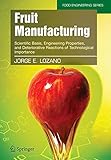Fruit Manufacturing : Scientific Basis, Engineering Properties, and Deteriorative Reactions of Technological Importance / by Jorge E. Lozano.
Tipo de material: TextoEditor: Boston, MA : Springer US, 2006Descripción: xiii, 230 páginas, recurso en líneaTipo de contenido:
TextoEditor: Boston, MA : Springer US, 2006Descripción: xiii, 230 páginas, recurso en líneaTipo de contenido: - texto
- computadora
- recurso en línea
- 9780387306162
- TP248.65.F66
Springer eBooks
Overview of the Fruit Processing Industry -- Processing of Fruits: Ambient and Low Temperature Processing -- Processing of Fruits: Elevated Temperature, Nonthermal and Miscellaneous Processing -- Thermodynamical, Thermophysical, and Rheological Properties of Fruits and Fruit Products -- Color, Turbidity, and Other Sensorial and Structural Properties of Fruits and Fruit Products -- Chemical Composition of Fruits and its Technological Importance -- Fruit Products, Deterioration by Browning -- Inhibition and Control of Browning.
The fruit processing industry is a major global business. While basic principles of fruit processing have shown only minor changes over the last years, major improvements continually occur. More efficient equipment is capable of converting huge quantities of fruits into pulp, juice, dehydrated, frozen and refrigerated products, etc. that make possible the preservation of products for year-round consumption. Fruit processing and storage involve physical and chemical changes that negatively modify fruit quality. The industry’s ability to provide a nutritious and healthful fruit product to the consumer is highly dependent on the knowledge of the quality modifications that occur during the processing. Fruit Manufacturing emphasizes the products rather than the processes, procedures, or plant operations. It presents the influence on a fruit product’s quality in relation to the different processing methods, from freezing to high temperature techniques, and discusses the origin of deterioration, kinetics of negative reactions, and methods for inhibition and control of the same. Probable changes in thermodynamical, thermophysical and rheological properties and parameters during processing of fruits at a wide range of soluble solids, temperatures and pressure are also summarized. This book provides the necessary information for the understanding of the deteriorative effects on the fruit quality during processing to engineers and professionals mainly involved in development and operations in the fruit industry.
Para consulta fuera de la UANL se requiere clave de acceso remoto.


